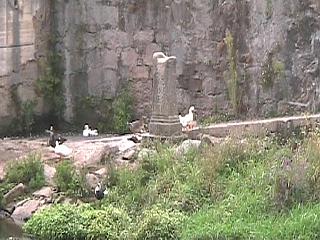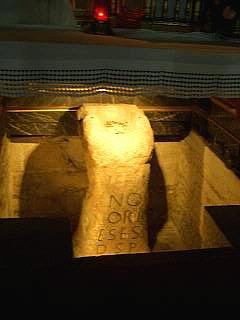Padron and Saint James
- I always struggle with definitive stories from history that detail, ad vim item, events from hundreds or thousands of years ago but, putting skepticism to one side, here is the Padron and St. James story. As tales go, it is a good one and parts of it are quite well supported by historical evidence.
The naming of Padron
Be it true or false, legend claims that Padron got its name from a large stone to which the boat, transporting the dead and decapitated body of the Apostle St.James, was tied during a stop off at "Iria Flavia" whilst on route to Santiago.
In the times of St. James, Padron and the areas around it were known as the "Iria lands" and were among the most heavily populated and traded in Galicia.

The actual stone, called the "Pedron", now rests on permanent display under the alter of Padron's parish church (the church of Santiago). You can visit the church and you are also free to photograph or video the Pedron if you wish. We also noticed a replica of the "Pedron" stone on the opposite river bank to the church of Santiago. See above and right.
On leaving Padron, St. James's remains were taken to Santiago by his disciples "Atanasius" and "Theodore" where they were interned. Both "Atanasius" and "Theodore" were subsequently interned next to their charge after their deaths.
Saint James and Spain
But whilst this is where the story ends, it is not where it originally started. Saint James first came, to what is now Spain, to spread the word of God on the instructions of Jesus and stayed there for several years.
When he arrived in Galicia (45 AD), he regularly preached at a rocky area above Padron called "Santiaguino del Monte" and he is also reputed to have caused a spring to spout water by bringing down his staff on solid rock as a demonstration of God's power to non believers. Both the elevated rocky preaching point and spring survive today and are visited by pilgrims following the "Way of St. James" pilgrimage to Santiago de Compostela.
So how did the apostle come to such an unpleasant end?

Unfortunately he returned to "Jaffa" (Palastine) where he was promptly sentenced to death and beheaded, I believe by King Herod whom he had originally fled. It was on hearing this news that his former aids Atanasius and Theodore made haste to "Jaffa" so as to bring back his remains. The significance of this story does of course increase as the connection with St. James's body, his local preaching and the Cathedral of Santiago de Compostela are added to the picture.
Left a picture of the Pedron

